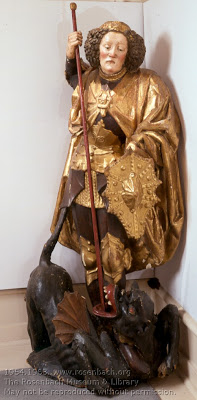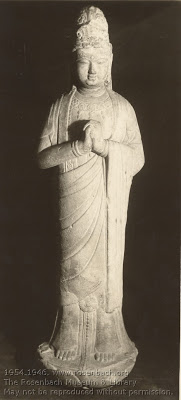When I emerge from my little hidey-hole off the reading room here at the Rosenbach, I come onto the third floor hall only to have my eyes alight upon this scene: Now, nothing against this fine piece, or more technically, this “polychrome carved and gilded lime wood figure of St. Michael slaying a demon” as our catalog describes it, but encountering the somewhat melancholy, nearly blasé St. Michael (one would think that slaying a dragon would evoke a more impassioned expression) ramming a spear down the throat of a dragon/demon who does, indeed, as our catalog further describes, have “teeth, wings, and protruding ribs and… a face on its posterior” (complete with curiously positioned nasal aperture…), can be a little disconcerting at times. I don’t run into the following sculpture nearly as often as I do St. Michael, as it’s tucked at the end of a second-floor hallway that isn’t a main thoroughfare in our historic house (and may be missed by visitors on a house tour as well), and so I hadn’t thought much about it:
Now, nothing against this fine piece, or more technically, this “polychrome carved and gilded lime wood figure of St. Michael slaying a demon” as our catalog describes it, but encountering the somewhat melancholy, nearly blasé St. Michael (one would think that slaying a dragon would evoke a more impassioned expression) ramming a spear down the throat of a dragon/demon who does, indeed, as our catalog further describes, have “teeth, wings, and protruding ribs and… a face on its posterior” (complete with curiously positioned nasal aperture…), can be a little disconcerting at times. I don’t run into the following sculpture nearly as often as I do St. Michael, as it’s tucked at the end of a second-floor hallway that isn’t a main thoroughfare in our historic house (and may be missed by visitors on a house tour as well), and so I hadn’t thought much about it:  I didn’t even know who or what it depicted. Walking down the hall towards it one day, though, I was struck by its pose — calm, serene, and with a slight downward tilt of the head (which may have something to do with the fact the sculpture had been decapitated at some point and the head reattached) that lends the figure a dignified, but not servile, slight bowing posture. It turns out this is a 5th-century Chinese statue of Quan Yin, the Bodhisattva of Compassion or, sometimes, the Goddess of Mercy. I know next to nothing about Quan Yin (though there seems to be some interesting gender-switching involved), but whoever sculpted this piece did a good job imbuing it with the appropriate feeling. Now, St. Michael is doing some important work up on the third floor, what with defeating the devil and thereby exiling him from heaven and for which we thank him most heartily, but sometimes it’s also good to encounter an ancient sculpture that quietly nods to the viewer and fosters a sense of mutual respect. A bit of background on Quan Yin (or Kuan Yin, or Kwan Yin )is here. (It’s funny how transliteration yields so many different spellings. It’s like the old Kurt/Curt/Kurdt/Qurt Cobain interview trick. New-agey music alert: if you click through, you might want to turn down your speakers.)Some attractive stained-glass images of St. Michael can be found here, courtesy of the Michigan State University Museum. Here’s the most surprising site I found while trolling for information on St. Michael. I honestly hadn’t given much thought to what Halloween decorations could do to a child’s soul. If you click through, prepare to grapple with that question. Images above: 1.Unknown artist: [sculpture of St. Michael].
I didn’t even know who or what it depicted. Walking down the hall towards it one day, though, I was struck by its pose — calm, serene, and with a slight downward tilt of the head (which may have something to do with the fact the sculpture had been decapitated at some point and the head reattached) that lends the figure a dignified, but not servile, slight bowing posture. It turns out this is a 5th-century Chinese statue of Quan Yin, the Bodhisattva of Compassion or, sometimes, the Goddess of Mercy. I know next to nothing about Quan Yin (though there seems to be some interesting gender-switching involved), but whoever sculpted this piece did a good job imbuing it with the appropriate feeling. Now, St. Michael is doing some important work up on the third floor, what with defeating the devil and thereby exiling him from heaven and for which we thank him most heartily, but sometimes it’s also good to encounter an ancient sculpture that quietly nods to the viewer and fosters a sense of mutual respect. A bit of background on Quan Yin (or Kuan Yin, or Kwan Yin )is here. (It’s funny how transliteration yields so many different spellings. It’s like the old Kurt/Curt/Kurdt/Qurt Cobain interview trick. New-agey music alert: if you click through, you might want to turn down your speakers.)Some attractive stained-glass images of St. Michael can be found here, courtesy of the Michigan State University Museum. Here’s the most surprising site I found while trolling for information on St. Michael. I honestly hadn’t given much thought to what Halloween decorations could do to a child’s soul. If you click through, prepare to grapple with that question. Images above: 1.Unknown artist: [sculpture of St. Michael].
Lime wood.
Southern Germany or Austria: [ca. 1500]. 1954.19632. Unknown artist: [sculpture of Quan Yin].
Stone.
China: [400-500 C.E.]1954.1946
